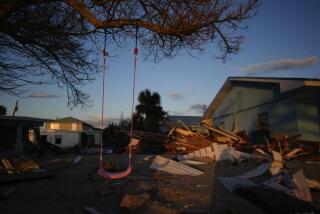Germ Sours Florida Citrus Industry
FORT PIERCE, Fla. — For more than 40 years, grapefruit grew juicy and ripe on this 1,200-acre grove inland from the Atlantic. Now there is little left but the jagged branches of torn-up trees, and spicy smoke fills the hot midday air as one by one, they are burned to powdery ash.
“This just makes me sick,” said John E. Quigley II, an environmental supervisor with the Florida Bureau of Pest Eradication and Control, who looked on as flames at least 15 feet high consumed yet another grapefruit tree. “I’m so disenchanted by this, it hurts.”
Last year’s hurricanes dropped a bacteriological bomb on Florida’s already sorely challenged citrus industry, widely dispersing a virulently contagious germ that causes citrus canker -- a disease harmless to humans and animals but ruinous to oranges and grapefruit. Florida officials say the possibility that hurricanes could further scatter the bacteria has created the most serious threat in decades to the state’s signature crops.
No chemical has been found that can destroy the germs without harming the trees. So last month, Florida’s Department of Agriculture announced a mammoth smash-and-burn effort to rid commercial groves of tainted or at-risk trees. It is the equivalent of destroying every tree in an area the size of Miami.
Until last summer, canker had been virtually eliminated in Florida except in two southeastern counties. The rain droplets borne by the shrieking winds of Hurricanes Charley, Frances and Jeanne carried the bacteria into 13 other counties, including prime commercial citrus-growing areas north of Fort Myers on the Gulf of Mexico and here on the Eastern seaboard about 120 miles north of Miami.
If nothing is done to combat the Xanthomonas axonopodis bacterium -- so tiny that 25,000 laid end-to-end would measure 1 inch -- it could doom Florida’s citrus industry, said Mark Fagan, a spokesman for the state Department of Agriculture’s canker eradication program.
“With the multitude of hosts out there, the thousands of acres, it’s got plenty of opportunity to spread,” Fagan said. “Eventually, it would devastate, wipe out, a $9-billion industry.”
Even as crews labored to erase the effects of the 2004 storms, more potential trouble loomed. Tropical Storm Katrina was projected to reach hurricane force, with sustained winds of 75 mph, before reaching Florida’s eastern coast Friday morning somewhere between Florida City, near the southern tip of Florida, and Vero Beach and the Indian River citrus area.
“We can only hope there is not a significant hit, and not much dispersal for the bacteria,” said Terence McElroy, Florida Agriculture Department spokesman in Tallahassee.
Citrus canker produces ugly brown lesions on leaves and fruit, debilitates trees, and causes up to half of their fruit to drop to the ground before ripening.
In 1915, Florida’s then much smaller citrus industry was menaced by an outbreak of canker that took almost two decades to contain and stamp out.
Since 1995, Florida and the U.S. government have spent about $500 million to control citrus canker, in what state and federal officials call the largest pest eradication program in history. About 5.4 million commercial and nursery citrus trees, and nearly 800,000 trees in homeowners’ yards, have been removed to arrest the disease.
In 2004, over protests from some homeowners, the Florida Supreme Court ruled the state had the right to chop down healthy citrus trees up to 1,900 feet from a sick tree to contain a malady that botanists say is as infectious for citrus as measles is among children. But last year’s hurricanes played havoc with Florida’s efforts at canker control.
Before the storms, about 15,900 acres of infected and exposed groves had been removed. The hurricanes so spread the bacteria that three times more grove was ordered destroyed.
Authorities were “walloped by this,” said Tyrone Kemp, a U.S. Department of Agriculture official in Plantation, Fla. “Like in war, they had to step back, retrench, and then go forward again.”
The state and federal governments budgeted more than $50 million this year for canker eradication.
Instead of tearing up and burning 30 acres of infected grove a day, the daily goal now is to eliminate 600 acres, or nearly a square mile. Bids have been solicited from landscaping and tree-removal companies.
“If we don’t have a catastrophic storm season, we can eradicate it,” state Agriculture Commissioner Charles H. Bronson said in announcing the stepped-up program. If not for last year’s hurricanes, Bronson said, canker in Florida might be history.
Last year, the Indian River area, which grows the state’s best grapefruit and oranges for eating, was lashed by Hurricanes Frances and Jeanne. The first signs of canker surfaced in January in a 30-acre grove.
“It took the wind out of me,” Quigley said. “I knew what was going to happen.”
So far this year, the disease has been detected in 66 locations in the five counties that make up the Indian River citrus district. On the wall of his office, Quigley has posted a map of known infection sites, and circles radiating 1,900 feet that encompass areas of citrus trees marked for death. It looks like a target map for an aerial bombardment.
“That’s what Jeanne and Frances did to us. They dropped a bomb on us,” Quigley said with grim humor.
Lately, his black GMC pickup has been nicknamed “Black Death” by grapefruit growers and orange growers who worry when they see it that the disease has been discovered in their area. The pest control official has been hiring contractors to uproot trees and burn them, then rototill the soil four times to break up roots so they can’t sprout.
Once big-scale eradication gets underway, state officials hope to destroy 5,000 acres of Indian River citrus grove in 45 days.
In Quigley’s 15 years as a Florida agricultural official, flattening so much productive land is the worst task he has ever had, he said. “Nothing else comes close.”
Florida’s citrus industry faces other challenges, including a decline in orange juice consumption from historic highs; competition from Brazil; demand for agricultural land for housing; and the risk of freezes or more hurricanes. But none of those problems has the destructive potential of canker, said Florida Agriculture Department spokesman McElroy.
“If citrus canker isn’t eradicated and eradicated quickly, then those other challenges will be moot, because there will be no citrus industry,” he said.
More to Read
Sign up for Essential California
The most important California stories and recommendations in your inbox every morning.
You may occasionally receive promotional content from the Los Angeles Times.










